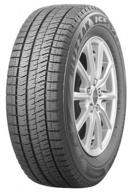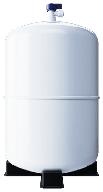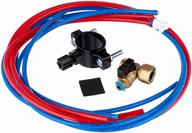
Review on Under sink filter Atoll A-550m STD 1/2" white by Petar Aleksiev ᠌

Reliable purchase, guaranteed to be a good purchase.
Atoll A-560Em and A-550m STD, both of which are simultaneously mentioned on the box, are the same system. In reality, it's just another marginally altered version of the tried-and-true A-560E / A-550 Max. Each of these systems has a mineralizer at the fifth stage, and everything that has been said about them in reviews on the market is 99% accurate for this model as well. You may learn more about the A-550 standard, which is essentially the same but uses a carbon post-filter in place of a mineralizer. Otherwise, the two are physically equivalent. I can still wholeheartedly advise anyone to install such or a comparable system at home, despite all the drawbacks outlined, which are primarily linked to installation and maintenance. Most likely, worries regarding the dependability of links are entirely theoretical. According to what I've read, placing an Aquastop valve at the system's entrance is advised because it should immediately cut off the water supply in the event of a leak. Personally, I don't see the logic in it. Even though I purchased it, I ultimately chose not to install it. Watch the video on the manufacturer of these valves' website for interest's sake; it only functions if the pressure after the valve is substantially lower than before it, meaning that when the water starts to flow out completely unhindered, it truly whips. Because there is some non-zero pressure in the section from the valve outlet to the aerator, Aquastop does not function in practice even if you simply open the faucet with an aerator. Imagine what resistance the water encounters as it travels through the system since there are already 5 filters in the Sabzhe system and the tank is replenished once an hour by a teaspoon. If you turn off the tank, take a look at what a weak trickle of water comes out of the faucet. Simply put, Aquastop is unable to detect such a minor leak. I'm not sure if you should put it on, but there won't be much of a defensive impact.
- 1. Having a reliable source of drinking water inside the home. It may sound cliché, but you will understand what I mean if you have ever experienced pain because you neglected to place a timely order for bottled water delivery. 2. You may be sure you're drinking genuinely clean water because everything is obvious and understandable: the same water was used at both the intake and the outflow. Who knows what is put into imported bottles, or how? 3. The water is now visibly softer and more delicious. From the first glass on, it is clear that the taste is entirely different. I'm not sure which has a bigger impact on this—the final mineralization or the effectiveness of impurity removal. It appears to be both. Although many report that there is a sizable distillate at the exit, I haven't personally experienced water from similar systems where the fifth stage is a carbon post-filter rather than a mineralizer. I therefore made the decision for myself to choose the mineralizer option in order to maintain the natural taste. 4. Specific directions. Actually, you can complete the installation yourself. Because they are all colored, the connecting tubes are easy to distinguish during self-assembly. Only the external colored hoses need to be connected; all internal wiring between the stages has already been completed. However, all but one of the filter parts will need to be placed independently, which is not at all difficult. 5. Ate Crane, which is more dependable and attractive than in earlier series. 6. It's quite likely that a pump to raise the pressure at the entrance is still unnecessary. Everything operates in a 12-story skyscraper, where I reside on the ninth floor. The minimum necessary pressure in the water supply system is 3 atm, as measured. The pressure coming from the tap is pretty typical, the tank is stable, and it fills up in about 1.5 hours. 7. The system is completely silent, even while filling the tank and draining the "technical" water into the siphon, contrary to what I had anticipated it would sound like. There are no additional sounds, at least not with a pump.
- 1. Having a constant source of drinking water in the home. It may sound cliché, but you will understand what I mean if you have ever experienced pain because you neglected to place a timely order for bottled water delivery. 2. You may be confident that the water you are drinking is indeed clean because everything is obvious and understandable: the same water was used at the intake and the same water was used at the output. Who knows what is put into imported bottles, or how? 3. The water is now visibly softer and more delicious. From the first glass on, it is clear that the taste is entirely different. I'm not sure which has a bigger impact on this—the final mineralization or the effectiveness of impurity removal. It appears to be both. Although many report that there is a sizable distillate at the exit, I haven't personally experienced water from similar systems where the fifth stage is a carbon post-filter rather than a mineralizer. I therefore made the decision for myself to choose the mineralizer option in order to maintain the natural taste. 4. Specific directions. Actually, you can complete the installation yourself. All connecting tubes are color-coded, making it easy to assemble yourself because you won't mix them up. All internal wiring between the stages has already been completed; all that is left to do is connect the external communication pipes. However, all but one of the filter parts will need to be placed independently, which is not at all difficult. 5. Ate Crane, which is more dependable and attractive than in earlier series. 6. It's quite likely that a pump to raise the pressure at the entrance is still unnecessary. Everything operates in a 12-story skyscraper, where I reside on the ninth floor. The minimum necessary pressure in the water supply system is 3 atm, as measured. The pressure coming from the tap is pretty typical, the tank is stable, and it fills up in about 1.5 hours. 7. The system is completely silent, even while filling the tank and draining the "technical" water into the siphon, contrary to what I had anticipated it would sound like. There are no additional sounds, at least not with a pump.
New products
Comments (0)
Top products in 💧 Water Purification
Another interesting products
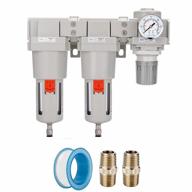
NANPU Air Drying System With Double Filters And Pressure Regulator Combo For Clean And Controlled Air Supply

18 Review

NANPU 3/8" NPT Compressed Air Filter Regulator Combo Piggyback, 5 Micron Brass Element, Poly Bowl, Semi-Auto Drain, Metal Bracket, 0-150 Psi Gauge

26 Review
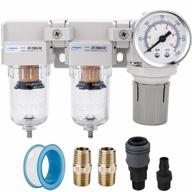
NANPU DFR-02 1/4" NPT Air Drying System - Double Air Filters, Air Pressure Regulator Combo - Semi-Auto Drain, Poly Bowl

20 Review
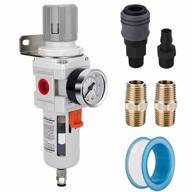
NANPU Compressed Air Filter Regulator Combo: Brass Element, Semi-Auto Drain, 0-150 Psi Gauge, And More

21 Review


